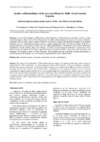Please use this identifier to cite or link to this item:
https://accedacris.ulpgc.es/handle/10553/106759
| DC Field | Value | Language |
|---|---|---|
| dc.contributor.author | Casamayor Font, Mariona | en_US |
| dc.contributor.author | Alonso, I. | en_US |
| dc.contributor.author | Sánchez García, María José | en_US |
| dc.contributor.author | Montoya Montes, Isabel | en_US |
| dc.contributor.author | Rodríguez,S. | en_US |
| dc.contributor.author | Mangas Viñuela, José | en_US |
| dc.date.accessioned | 2021-04-13T13:41:36Z | - |
| dc.date.available | 2021-04-13T13:41:36Z | - |
| dc.date.issued | 2019 | en_US |
| dc.identifier.isbn | 978-84-09-12002-4 | en_US |
| dc.identifier.uri | https://accedacris.ulpgc.es/handle/10553/106759 | - |
| dc.description.abstract | La costa del municipio de Telde (Gran Canaria, España) se caracteriza por ser recortada y contar con gran cantidad de playas aisladas entre sí. Este trabajo aborda el análisis sedimentológico de cinco de estas playas (Salinetas, Aguadulce, Ojos de Garza, Ámbar y Gando) a partir de un total de 82 muestras de sedimento recogidas en los distintos ambientes costeros, incluyendo la plataforma interna, la playa propiamente dicha y las dunas asociadas. Se llevaron a cabo granulometrías y calcimetrías de todas ellas. Los análisis granulométricos determinaron que no existen diferencias significativas entre las distintas playas. Sin embargo, se obtuvo que el porcentaje de carbonatos aumenta hacia el sur, siendo la playa de Salinetas la de mayores aportes terrígenos y la playa de Ámbar, la que cuenta con sedimentos más biogénicos. No obstante, la playa de Gando constituye una excepción dado que no presenta un patrón diferenciado ni textural ni composicionalmente, ya que se encuentra resguardada por la península de Gando. | en_US |
| dc.description.abstract | The coast of the municipality of Telde (Gran Canaria, Spain) is an indented coast with a large number of isolated beaches. This work focuses on sedimentological analysis of five beaches in this area (Salinetas, Aguadulce, Ojos de Garza, £mbar and Gando). A total of 82 sediment samples were collected in the different coastal environments, including internal shelf, beaches and associated dunes. Granulometric and calcimetric analyses were carried out. Granulometric analyses pointed out that there are no significant differences among the five beaches. However, it can be noticed that the percentage of carbonates increases southwards. Thus, Salinetas beach shows the largest proportion of terrigenous sediment supply and £mbar sediments are the most biogenic ones. In addition, Gando beach represents an exception because neither textural pattern nor compositional one are differentiated, since the beach is sheltered by the Gando peninsula. | en_US |
| dc.language | spa | en_US |
| dc.publisher | Consejo Superior de Investigaciones Científicas (CSIC) | en_US |
| dc.source | X Jornadas de Geomorfología Litoral. Libro de ponencias / Durán, R., Guillén, J., Simarro, G. (eds), p. 49-52 | en_US |
| dc.subject | 250607 Geomorfología | en_US |
| dc.subject | 250618 Sedimentología | en_US |
| dc.subject.other | Grain size | en_US |
| dc.subject.other | Carbonates | en_US |
| dc.subject.other | Dune fields | en_US |
| dc.subject.other | Geodynamic processes | en_US |
| dc.title | Análisis sedimentológico de la costa meridional de Telde (Gran Canaria, España) | en_US |
| dc.title.alternative | Sedimentological analysis along southern Telde coast (Gran Canaria, Spain) | en_US |
| dc.type | info:eu-repo/semantics/conferenceobject | en_US |
| dc.type | ConferenceObject | en_US |
| dc.relation.conference | X Jornadas de Geomorfología litoral | en_US |
| dc.description.lastpage | 52 | en_US |
| dc.description.firstpage | 49 | en_US |
| dc.investigacion | Ciencias | en_US |
| dc.type2 | Actas de congresos | en_US |
| dc.description.numberofpages | 4 | en_US |
| dc.utils.revision | Sí | en_US |
| dc.identifier.ulpgc | Sí | en_US |
| dc.contributor.buulpgc | BU-BAS | en_US |
| item.fulltext | Con texto completo | - |
| item.grantfulltext | open | - |
| crisitem.author.dept | GIR IOCAG: Geología Aplicada y Regional | - |
| crisitem.author.dept | IU de Oceanografía y Cambio Global | - |
| crisitem.author.dept | GIR IOCAG: Geología Aplicada y Regional | - |
| crisitem.author.dept | IU de Oceanografía y Cambio Global | - |
| crisitem.author.dept | GIR IOCAG: Geología Aplicada y Regional | - |
| crisitem.author.dept | IU de Oceanografía y Cambio Global | - |
| crisitem.author.dept | Departamento de Física | - |
| crisitem.author.dept | GIR IOCAG: Geología Aplicada y Regional | - |
| crisitem.author.dept | IU de Oceanografía y Cambio Global | - |
| crisitem.author.dept | Departamento de Física | - |
| crisitem.author.dept | GIR IOCAG: Geología Aplicada y Regional | - |
| crisitem.author.dept | IU de Oceanografía y Cambio Global | - |
| crisitem.author.dept | Departamento de Física | - |
| crisitem.author.orcid | 0000-0003-4080-3038 | - |
| crisitem.author.orcid | 0000-0002-9663-0773 | - |
| crisitem.author.orcid | 0000-0002-9490-9914 | - |
| crisitem.author.orcid | 0000-0001-5401-3841 | - |
| crisitem.author.orcid | 0000-0002-3286-743X | - |
| crisitem.author.parentorg | IU de Oceanografía y Cambio Global | - |
| crisitem.author.parentorg | IU de Oceanografía y Cambio Global | - |
| crisitem.author.parentorg | IU de Oceanografía y Cambio Global | - |
| crisitem.author.parentorg | IU de Oceanografía y Cambio Global | - |
| crisitem.author.parentorg | IU de Oceanografía y Cambio Global | - |
| crisitem.author.fullName | Casamayor Font, Mariona | - |
| crisitem.author.fullName | Alonso Bilbao,Ignacio | - |
| crisitem.author.fullName | Sánchez García, María José | - |
| crisitem.author.fullName | Montoya Montes, Isabel | - |
| crisitem.author.fullName | Mangas Viñuela, José | - |
| crisitem.event.eventsstartdate | 04-09-2019 | - |
| crisitem.event.eventsenddate | 06-09-2019 | - |
| Appears in Collections: | Actas de congresos | |
Page view(s)
227
checked on Oct 12, 2024
Download(s)
131
checked on Oct 12, 2024
Google ScholarTM
Check
Altmetric
Share
Export metadata
Items in accedaCRIS are protected by copyright, with all rights reserved, unless otherwise indicated.
